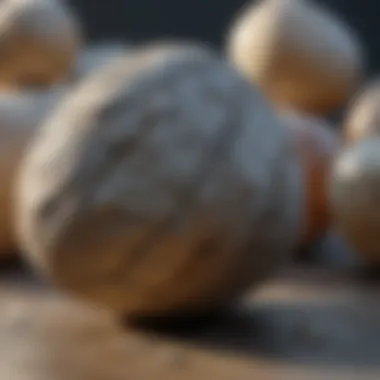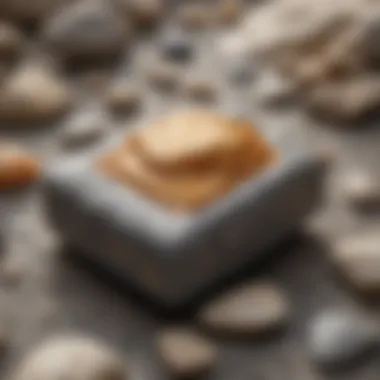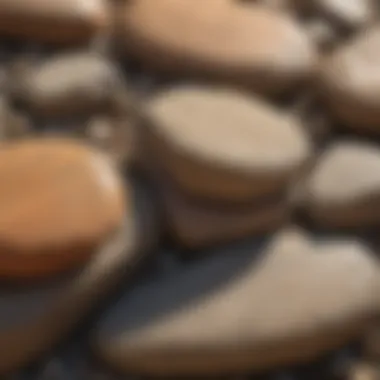A Collector's Guide to Choosing the Best Stone Glue for Rock and Fossil Projects


Rock and Fossil Identification
As a dedicated rock and fossil collector, identifying the types of rocks and fossils you encounter is essential for understanding their nature and value. Different rocks and fossils exhibit distinct characteristics, such as color, texture, and markings, which can offer clues to their composition and origin. Utilizing tools like magnifying glasses, UV lights, and geological hammers can aid in the identification process, allowing collectors to classify specimens accurately and expand their knowledge base.
Choosing the Best Glue for Stone
When embarking on stone projects as a passionate rock and fossil collector, selecting the most suitable glue is paramount for ensuring the longevity and integrity of your creations. With a wide array of adhesives available, each with varying properties and applications, it's crucial to understand the specific needs of your project to make an informed decision. From cyanoacrylate glues for instant bonding to epoxy resins for durable results, exploring the characteristics of different types of adhesives can enhance your crafting endeavors and elevate your skills.
Collecting Tips and Techniques
Mastering the art of collecting rocks and fossils requires a combination of expertise, patience, and strategic planning. Adopting best practices such as obtaining necessary permits, respecting natural habitats, and documenting specimen details can contribute to a fulfilling and ethical collecting experience. By researching prime collecting sites, engaging in safe extraction techniques, and employing proper tools like chisels and brushes, collectors can harvest specimens effectively while preserving the environment and respecting geological formations.
Preservation and Display
After gathering a diverse array of rocks and fossils, preserving and displaying them with care is essential for showcasing their beauty and significance. Employing techniques like cleaning with mild detergents, drying in a controlled environment, and storing in acid-free paper can safeguard specimens from deterioration and maintain their integrity over time. With creative display ideas such as shadow boxes, floating shelves, and custom-built cabinets, collectors can transform their collections into captivating showcases that reflect their passion and expertise.
Geological Insights
Delving into the geological aspects of rocks and fossils can provide a deeper appreciation of their history, formation, and evolution. Exploring geological formations and processes like sedimentation, metamorphism, and fossilization unveils the complex pathways that have shaped Earth's landscape and enriched its biodiversity. Recognizing the historical significance of rocks and fossils, including their role in scientific discoveries and cultural heritage, offers valuable insights into the evolution of life on our planet and the contributions of pioneering geologists and paleontologists.
Introduction
In the meticulous world of rock and fossil collecting, the choice of adhesive for stone projects holds paramount importance. This comprehensive guide aims to enlighten enthusiasts at all levels on the critical nuances of selecting the best glue for their endeavors. Understanding the properties, applications, and techniques of various adhesives is quintessential for achieving optimal results in crafting masterpiece creations that withstand the test of time.
Importance of Choosing the Right Glue for Stone Projects
Impact on Longevity of Projects
When considering the impact on the longevity of stone projects, the choice of glue plays a pivotal role. The durability and longevity of a project heavily rely on the adhesive's ability to withstand environmental factors, stress, and time. Opting for an adhesive with high resistance to weathering, water exposure, and vibrations ensures that the stone artifacts remain intact and unblemished throughout the years. Exploring adhesives renowned for their longevity-promoting properties is integral to the crafting process for rock and fossil collectors.
Aesthetics and Finish
Achieving a flawless finish and impeccable aesthetics in stone projects often hinge on the choice of the right adhesive. The bonding agent's transparency, color, and texture profoundly impact the visual appeal of the final creation. Selecting an adhesive that seamlessly blends with the stones, enhancing their natural beauty, elevates the overall allure of the crafted piece. Striking a balance between structural strength and aesthetic appeal is a cornerstone in the art of stone crafting, underscoring the significance of choosing the correct adhesive.
Handling and Durability
The handling characteristics and durability of the chosen adhesive significantly influence the crafting process and the ultimate quality of the project. A robust adhesive that offers ease of application, precision in bonding, and flexibility in curing time simplifies the intricate task of assembling diverse stone elements. Moreover, an adhesive that endures stress, temperature variations, and external pressures ensures the long-lasting integrity of the crafted artifact. Prioritizing adhesives known for their exceptional handling and durable properties is vital for successful stone projects.
Considerations for Rock and Fossil Collectors
Material Compatibility
Material compatibility stands as a crucial consideration for rock and fossil collectors embarking on stone projects. Selecting an adhesive tailored to the specific properties of the stones in use is paramount for achieving a strong and lasting bond. Understanding the interaction between the adhesive and the stones, including porosity, composition, and texture, is foundational in ensuring a secure and seamless union. Choosing adhesives designed to bond effectively with a broad spectrum of stone materials enhances the versatility and reliability of crafting endeavors.
Strength and Bonding Properties
The strength and bonding properties of an adhesive dictate the structural integrity and resilience of the finished stone project. Opting for adhesives with high bonding strength, shear resistance, and impact durability guarantees the stability of intricate assemblies and delicate formations. Exploring adhesives known for their superior bonding properties tailored to the demands of stone crafting empowers collectors to create enduring masterpieces that stand the test of time.
Ease of Application
Ease of application plays a pivotal role in the crafting process for rock and fossil collectors. An adhesive that offers simplicity in application, precision in dosage, and versatility in bonding techniques streamlines the construction of intricate stone arrangements. Furthermore, adhesives that facilitate quick curing, minimal exudation, and easy cleanup enhance the efficiency and convenience of the crafting experience. Prioritizing adhesives renowned for their user-friendly application characteristics optimizes the creative journey for collectors, ensuring a seamless and rewarding crafting process.
Types of Glue for Stone
In the realm of rock and fossil collecting, the choice of glue plays a vital role in the success and longevity of projects. Understanding the distinct properties and benefits of different types of adhesives is crucial for achieving optimal results. Rock and fossil collectors should pay close attention to the specific elements that various glue types offer to ensure their projects stand the test of time.


Epoxy Adhesives
Features and Benefits
Epoxy adhesives are renowned for their exceptional durability and strength, making them a preferred choice for stone projects. The key characteristic of epoxy adhesives lies in their ability to create robust bonds that withstand environmental factors and the test of time. Their strong adhesion properties make them ideal for bonding stones securely, ensuring the integrity of the final piece. While epoxy adhesives offer unmatched strength, the longer curing time may require patience but guarantees a reliable and long-lasting bond for rock and fossil collectors.
Suitable Applications
Epoxy adhesives excel in diverse applications, ranging from repairing fossils to creating intricate rock displays. Their versatility in bonding various types of stones and fossils makes them a go-to option for collectors looking for a reliable adhesive. Whether working with porous or non-porous materials, epoxy adhesives provide a strong and permanent bond that can withstand the rigors of handling and display.
Tips for Effective Use
When using epoxy adhesives in stone projects, it is essential to follow specific tips for optimal results. Mixing the components thoroughly and in the right proportions is crucial for activating the adhesive's bonding properties. Additionally, applying the epoxy in thin layers ensures even distribution and a strong bond. Rock and fossil collectors should take care to avoid excess adhesive, as it can affect the final aesthetic and durability of the project.
Cyanoacrylate (Super Glue)
Advantages and Limitations
Cyanoacrylate, commonly known as super glue, offers rapid bonding capabilities, making it ideal for quick fixes and small projects. The key characteristic of super glue lies in its fast setting time, allowing for instant results. While its quick-drying nature is advantageous for immediate bonding needs, super glue may not provide the long-term durability required for extensive stone projects.
Best Uses in Stone Projects
Super glue finds its best use in stone projects that require swift repairs or minor adjustments. Its ability to bond stones rapidly makes it suitable for temporary fixes or delicate arrangements. However, for projects demanding a lasting and robust bond, other adhesive options like epoxy may be more appropriate.
Precautions for Handling
When working with cyanoacrylate adhesives, rock and fossil collectors should exercise caution due to their strong bonding properties. Accidental skin contact or exposure to eyes can lead to adhesion, requiring immediate medical attention. Proper ventilation and handling protocols should be followed to prevent unnecessary accidents and ensure a safe working environment for collectors.
Polyurethane Adhesives
Characteristics and Applications
Polyurethane adhesives offer unique characteristics that make them suitable for a variety of stone projects. Their flexibility and resistance to water make them ideal for outdoor displays or projects exposed to moisture. The key characteristic of polyurethane adhesives lies in their ability to expand slightly during curing, filling gaps and ensuring a tight bond between stones.
Pros and Cons for Stone Projects
In stone projects, the versatility of polyurethane adhesives shines through their ability to bond a wide range of materials, including porous stones that may be challenging for other adhesives. However, their longer curing time and potential foaming during application may require careful handling to achieve desired results. Rock and fossil collectors should weigh these factors when considering polyurethane adhesives for their projects.
Application Techniques
When applying polyurethane adhesives, ensuring proper surface preparation is vital for a successful bond. Roughening the surfaces to be joined enhances adhesion, while carefully controlling the amount of adhesive used prevents excess foam and ensures a clean finish. Utilizing mixing nozzles can aid in precise application, while testing the adhesive's strength post-cure confirms the integrity of the bond.
Silicone Sealants
Versatility in Stone Projects
Silicone sealants offer vast versatility in stone projects, providing sealing and waterproofing properties essential for preserving the integrity of displays or arrangements exposed to moisture. Their flexibility and resistance to weathering make them a popular choice for outdoor stone art installations or fossil displays subject to environmental elements.
Waterproofing and Sealing Properties
The key characteristic of silicone sealants lies in their ability to create a watertight seal that protects stones and fossils from water damage or degradation. This makes them an excellent choice for sealing gaps or cracks in stone projects, ensuring long-term durability and preservation of the materials. Whether used for outdoor rock displays or indoor fossil collections, silicone sealants provide reliable waterproofing solutions.
Compatibility Considerations
When selecting silicone sealants for stone projects, considering compatibility with different materials is essential to prevent undesired reactions or adhesion issues. Rock and fossil collectors should ensure the sealant is suitable for the specific stones and fossils being bonded, as mismatched products can compromise the integrity of the project. Understanding the compatibility factors of silicone sealants enhances the success of bonding applications.
Factors to Consider When Choosing Glue for Stone


In the realm of rock and fossil collecting, the selection of the appropriate glue for stone projects is crucial to the success and longevity of crafted pieces. An understanding of various factors can significantly impact the outcome of the project, ranging from aesthetics to durability. When contemplating the choice of adhesive, considerations such as material compatibility, strength, ease of application, setting time, cost, and environmental impact play a pivotal role. Each factor requires careful assessment and integration to ensure the optimal selection for your stone projects.
Setting Time and Curing
Impact on Project Timelines
The setting time and curing process of the glue utilized in stone projects directly influence the efficiency and timeline of the crafting endeavor. A quick-setting adhesive may be favored for projects requiring rapid completion, while a slower curing option allows for meticulous adjustments. The choice of the right setting time aligns with the project's specific requirements, whether for intricate detailing or swift assembly. Understanding the impact of these timelines is crucial in achieving the desired results within the stipulated project duration.
Handling During Cure Period
Effective handling during the curing period of the adhesive is essential for the overall structural integrity of the stone project. Proper support and alignment mechanisms during this phase prevent misalignments or disruptions, ensuring a seamless bond post-cure. Careful consideration of handling techniques contributes to the overall quality and durability of the bonded stones, emphasizing the importance of precision and patience throughout the curing process.
Curing Temperature Considerations
Temperature variations play a significant role in the curing process of adhesives for stone projects. Understanding the optimal curing temperature specified by the adhesive manufacturer is pivotal for achieving the desired bonding strength. Factors such as ambient temperature, humidity levels, and curing duration all interact to influence the efficacy of the adhesive. By adhering to recommended temperature considerations during curing, collectors can enhance the durability and longevity of their stone creations.
Clarity and Color Matching
Aesthetics and Visual Appeal
The clarity and color matching of the adhesive in stone projects contribute significantly to the final aesthetic appeal. Opting for a transparent adhesive enhances the seamless integration of stones, showcasing the natural beauty of the materials without any distracting residues. Similarly, color-matched adhesives blend harmoniously with the stones, creating a visually cohesive end product. Understanding the aesthetic implications of clarity and color ensures a visually pleasing and professional finish for rock and fossil collectors.
Tips for Color Blending
In cases where color matching is essential for seamless repairs or assemblies, mastering the art of color blending becomes paramount. Utilizing color pigments or precise blending techniques allows collectors to achieve nuanced shades that seamlessly complement the stones being bonded. By experimenting with different ratios and pigments, enthusiasts can refine their color-matching skills, resulting in flawlessly integrated repairs or creations.
Transparent vs. Colored Adhesives
The debate between transparent and colored adhesives in stone projects hinges on the desired aesthetic outcome. Transparent adhesives offer invisible bonding, ideal for crystals, gems, or transparent stones, preserving their natural appearance. On the other hand, colored adhesives can either complement or contrast with the stones, adding a creative element to the overall design. Understanding the choice between transparent and colored adhesives empowers collectors to align their selections with the aesthetic vision of their projects.
Cost and Value
Balancing Quality and Budget
Finding the delicate balance between the quality and cost of adhesives is a critical consideration for rock and fossil collectors embarking on various projects. Investing in high-quality adhesives ensures robust bonding and longevity, safeguarding the integrity of crafted pieces over time. However, aligning the adhesive quality with budgetary constraints necessitates a strategic approach, where cost-effective options with adequate performance are sought to optimize value without compromising on outcomes.
Economic Considerations for Large Projects
When undertaking expansive stone projects, economic considerations come to the forefront, impacting decisions regarding adhesive procurement. The scale of the project necessitates cost-effective solutions that deliver reliable bonding within the project scope. Evaluating bulk purchase options, discounts for large quantities, and long-term durability projections aid in making informed decisions regarding adhesive selection for large-scale endeavors.
Long-Term Durability vs. Initial Investment
The juxtaposition of long-term durability versus initial investment encapsulates the strategic decision-making process for collectors. While high-cost adhesives may promise extended longevity and resilience, assessing the long-term benefits against the initial financial outlay is crucial. Balancing durability requirements with the upfront investment ensures that stone projects endure the test of time without compromising on quality or structural integrity.
Safety and Environmental Impact
Toxicity and Hazardous Chemicals
Understanding the toxicity levels and composition of adhesives is paramount for ensuring the safety of both crafters and the environment. Opting for adhesives with low toxicity and minimal hazardous chemicals minimizes health risks during application and handling. Prioritizing safety by excluding toxic elements from adhesives cultivates a secure crafting environment, aligning with sustainable practices essential for responsible creation in the rock and fossil collecting community.
Eco-Friendly Options
Embracing eco-friendly adhesive options resonates with the ethos of sustainability and environmental consciousness among rock and fossil collectors. Transitioning towards adhesives formulated with environmentally friendly components reduces ecological footprints and promotes a greener approach to crafting. By supporting eco-conscious brands and products, collectors champion environmental stewardship while maintaining the quality and performance standards required for successful stone projects.
Proper Disposal Practices
Implementing proper disposal practices for adhesive remnants and containers fosters a culture of environmental responsibility within the rock and fossil collecting community. Ensuring that unused adhesives are appropriately disposed of according to local regulations prevents environmental harm and contributes to waste reduction efforts. By advocating for conscientious disposal habits, collectors actively participate in preserving the ecological balance while nurturing a sustainable crafting environment.


Tips for Successful Bonding
Within the realm of stone projects, the significance of mastering the art of successful bonding cannot be overstated. The very foundation of a durable and visually appealing creation lies in the expert application of adhesive techniques. In this comprehensive guide tailored for rock and fossil collectors, the section on Tips for Successful Bonding delves deep into the essential elements required to achieve impeccable results. Encompassing a range of specific considerations, benefits, and nuances, this segment equips enthusiasts at all skill levels with invaluable insights to elevate their crafting endeavors to new heights.
Surface Preparation
Cleaning and Drying
Cleaning and Drying represent the initial steps in the meticulous art of stone bonding, setting the stage for a seamless adhesive application process. By emphasizing cleanliness and dryness, this aspect ensures optimal adhesion and bonding strength. The meticulous approach to Cleaning and Drying is paramount for enhancing the overall cohesion and longevity of stone projects. Rock and fossil collectors stand to benefit significantly from the impeccable foundation laid by these preparatory steps, facilitating a flawless bonding experience.
Roughening for Adhesion
Roughening for Adhesion plays a pivotal role in enhancing the surface area for adhesive application, promoting stronger and more resilient bonds. This technique effectively increases the mechanical interlocking between surfaces, contributing to enhanced adhesion properties and overall bond strength. While showcasing a distinctive approach, Roughening for Adhesion proves to be a popular choice in stone projects for its demonstrated ability to bolster bond durability and longevity.
Dealing with Porous Surfaces
Addressing the challenges posed by porous surfaces, Dealing with Porous Surfaces emerges as a critical aspect in the successful bonding of stones. By selecting suitable adhesives and techniques tailored to porous substrates, rock and fossil collectors can overcome potential pitfalls and ensure a secure and lasting bond. The unique feature of Dealing with Porous Surfaces lies in its ability to adapt to varied surface textures, thereby offering a versatile solution for achieving optimal bonding outcomes.
Application Techniques
Applying Thin vs. Thick Layers
The strategic decision between Applying Thin vs. Thick Layers of adhesive plays a fundamental role in determining the strength and aesthetics of stone bonds. While thin layers exhibit quick curing times and minimal visibility, thick layers provide robust support and fill gaps effectively. Balancing these contrasting attributes is crucial for achieving the desired adhesive coverage and structural integrity in diverse stone projects.
Utilizing Mixing Nozzles
Optimizing adhesive application through the efficient use of Mixing Nozzles streamlines the bonding process, ensuring precise and uniform distribution of adhesives. By incorporating Mixing Nozzles into the application regimen, rock and fossil collectors can achieve consistent and controlled adhesive dispensing, enhancing the accuracy and efficiency of bonding operations. This distinctive feature of Mixing Nozzles enhances the overall user experience and promotes enhanced adhesive performance in stone projects.
Avoiding Excess Adhesive
Vigilance in Avoiding Excess Adhesive is paramount to preventing undesired outcomes such as seepage, overflow, and visual blemishes in stone bonding. The judicious application of adhesives, coupled with meticulous attention to detail, safeguards against the pitfalls associated with excessive adhesive usage. By prioritizing precision and moderation in adhesive application, crafters can ensure clean, professional-looking results while minimizing wastage and clean-up efforts.
Curing and Drying
Optimal Conditions for Cure
Safeguarding the curing process with Optimal Conditions for Cure is essential to achieving the full potential of adhesive bonds in stone projects. By adhering to recommended temperature and humidity levels during curing, crafters can bolster the strength and integrity of their creations. The unique feature of Optimal Conditions for Cure lies in its ability to expedite the curing process without compromising the quality and durability of bonding outcomes.
Post-Bonding Handling
Post-Bonding Handling represents a crucial phase where delicacy and care are paramount to preserving the integrity of freshly bonded stone structures. By adopting appropriate handling protocols post-bonding, collectors can prevent accidental damage, distortions, or premature detachment of bonded elements. The key characteristic of Post-Bonding Handling is its role in ensuring the sustained quality and longevity of stone projects, thereby maximizing the impact and aesthetics of the final creation.
Testing for Full Strength
Verifying the full strength of adhesive bonds through Testing for Full Strength serves as a critical validation step in the stone bonding process. By subjecting bonded components to rigorous strength tests, crafters can assess the reliability and durability of their adhesive applications. The advantages of Testing for Full Strength lie in its capacity to instill confidence in the structural integrity of stone projects, offering reassurance of long-term performance and stability.
Conclusion
In the realm of rock and fossil collecting, the glue you choose plays a critical role in the longevity and aesthetics of your projects. This article has delved into the multifaceted world of selecting the best glue for stone projects, aiming to equip enthusiasts with the knowledge needed to make informed decisions. By understanding the importance of material compatibility, bonding strength, and ease of application, collectors can elevate their craft to new heights, ensuring their creations endure the test of time.
Final Thoughts on Gluing Stones in Collecting Projects
Choosing the Right Adhesive
Choosing the right adhesive is a pivotal decision for any stone project enthusiast. The adhesive acts as the backbone of your creations, dictating the durability, stability, and overall quality of the finished piece. Opting for an adhesive with superior bonding properties and material compatibility is paramount for ensuring your projects withstand the rigors of time and handling. This strategic selection not only enhances the structural integrity of your creations but also elevates the visual appeal, ensuring a seamless finish that reflects true craftsmanship.
Ensuring Longevity and Integrity
Ensuring the longevity and integrity of your stone projects goes hand in hand with selecting the right adhesive. By prioritizing adhesives known for their exceptional strength and durability, collectors can rest assured that their creations will stand the test of time. This focus on longevity not only preserves the aesthetic beauty of the work but also safeguards against potential damage or wear, allowing collectors to admire their pieces for years to come.
Enjoying the Crafting Process
While the technical aspects of selecting the right adhesive are crucial, it's equally important to find joy in the crafting process. Engaging in stone projects offers a unique opportunity for creativity and self-expression. By relishing each step of the crafting journey, from selecting the perfect adhesive to witnessing the transformation of raw materials into intricate creations, enthusiasts can cultivate a deeper appreciation for the art of stone collecting. Embracing the crafting process not only enriches the final outcome but also fosters a sense of fulfillment and accomplishment in bringing ideas to life.







